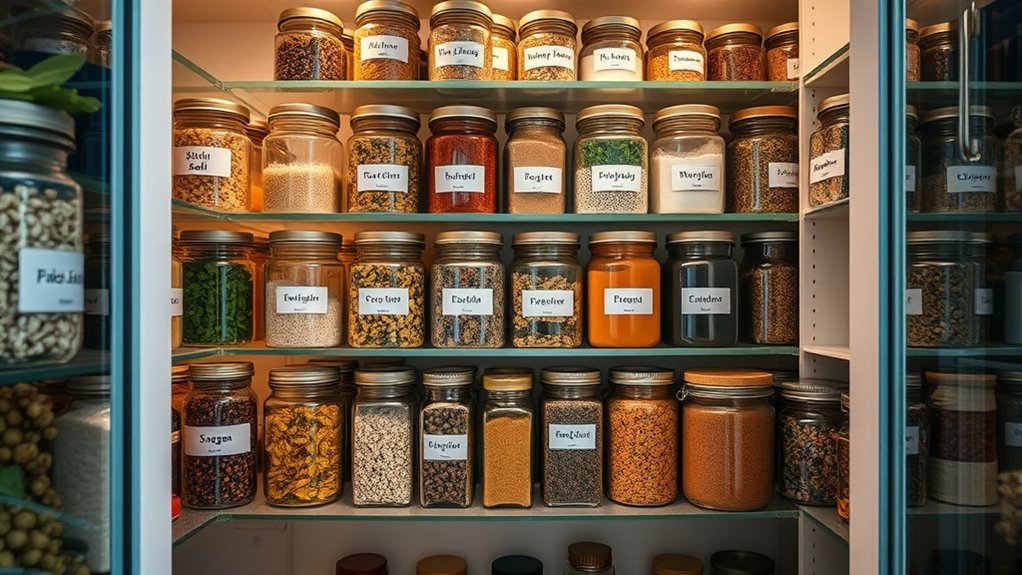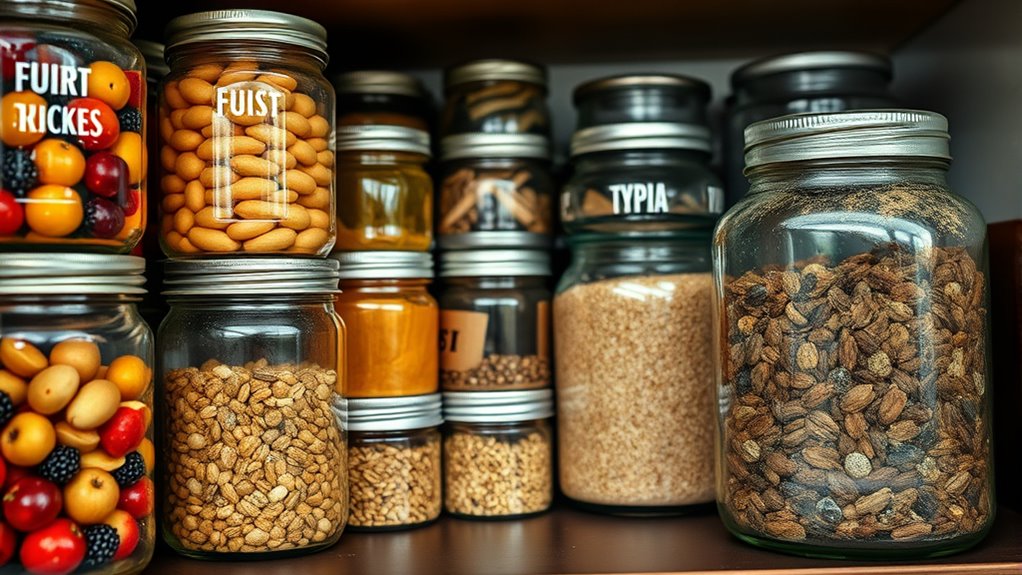Proper storage conditions are vital because they directly impact the quality and safety of your products. Poor humidity, exposure to light, or high temperatures can cause spoilage, nutrient loss, or deterioration of active ingredients. By controlling environment factors like humidity, light, and temperature, you can greatly extend shelf life and maintain effectiveness. Keep these elements in check, and you’ll guarantee your products stay fresh longer—more important than you might realize. Keep exploring to discover how to optimize your storage!
Key Takeaways
- Proper storage prevents microbial growth and spoilage, significantly extending product usability.
- Controlling humidity and light exposure preserves active ingredients and prevents deterioration.
- Inadequate conditions accelerate degradation, reducing shelf life and risking safety.
- Using appropriate containers and environment controls maintains product quality over time.
- Effective storage management minimizes waste, saves costs, and ensures consistent product effectiveness.

Proper storage conditions are essential for maintaining the quality and safety of your products. When you’re storing items, whether they’re food, pharmaceuticals, or other perishable goods, neglecting the environment can drastically shorten their shelf life. Two critical factors you might overlook are humidity control and light exposure. Managing these can mean the difference between your product staying fresh and it going bad prematurely.
Proper storage is key to preserving quality by controlling humidity and light exposure.
Humidity control plays a vital role in preserving your products. High humidity levels encourage mold growth, cause packaging to weaken, and accelerate spoilage. If you don’t keep the humidity in check, you risk moisture buildup that can lead to microbial growth or product degradation. Conversely, overly dry conditions can cause certain items, like dried herbs or powders, to become brittle or lose potency. To prevent these issues, you should use dehumidifiers or moisture-absorbing packets to maintain an ideal environment. Regularly monitoring humidity levels helps you react swiftly if conditions shift, ensuring your products stay in the best possible state.
Light exposure is another often underestimated factor that impacts shelf life. Ultraviolet (UV) rays and bright light can break down active ingredients in medications, cause discoloration, and degrade flavors or nutrients in food products. If you leave items exposed to direct sunlight or strong artificial lighting, you accelerate their deterioration. Protecting your products involves storing them in opaque containers or in dark, cool spaces away from light sources. Using light-proof storage cabinets or containers with UV filters can substantially extend shelf life. Even if you think a little light exposure won’t harm your product, over time, it can cause cumulative damage that reduces effectiveness and quality.
Understanding the interplay between humidity control and light exposure helps you create an environment that maximizes shelf life. For example, storing medications in a cool, dark, and dry place keeps them potent longer. Similarly, keeping perishable foods in airtight containers away from light not only preserves flavor but also prevents spoilage. Remember, storage isn’t just about keeping things out of sight; it’s about actively controlling environmental factors that influence product stability. Regularly checking storage conditions, adjusting humidity levels, and shielding items from light are simple steps that pay off by extending the usability and safety of your products.
In the end, paying close attention to these factors can save you money, reduce waste, and ensure the quality your customers or yourself expect. Proper storage isn’t just a routine task; it’s a crucial part of maintaining the integrity and shelf life of your products.
Frequently Asked Questions
How Does Humidity Specifically Affect Product Longevity?
Humidity specifically affects product longevity by creating the perfect environment for moisture buildup. When humidity levels are high, it becomes harder to control moisture, leading to mold, spoilage, or degradation of your products. Proper humidity control and moisture prevention are essential to extend shelf life. By maintaining ideal humidity levels, you reduce the risk of damage, ensuring your products stay fresh and safe for longer periods.
Do Storage Containers Impact Shelf Life?
Ever wondered if your storage containers truly protect your products? Yes, they do, especially if you choose airtight packaging made from durable materials. These containers prevent moisture, air, and contaminants from entering, markedly extending shelf life. Material durability ensures they won’t crack or degrade over time, maintaining a sealed environment. Proper containers keep your items fresh longer, making a real difference in preserving quality and reducing waste.
Can Temperature Fluctuations Damage Stored Items?
Temperature fluctuations can definitely damage your stored items. When temperatures change unpredictably, it disrupts temperature stability, leading to potential spoilage or deterioration. These fluctuations also create gaps in pest prevention, making your storage more vulnerable to pests that thrive in inconsistent conditions. To protect your items, keep storage areas at a steady temperature and minimize fluctuations, ensuring both quality and safety are maintained.
Is There a Difference Between Indoor and Outdoor Storage?
Yes, there’s a difference between indoor and outdoor storage. Your storage location exposes your items to different environmental factors—outdoor storage faces more temperature swings, humidity, and dirt, which can damage your belongings. Indoor storage usually provides more stable conditions, protecting against weather and pests. Choosing the right location depends on the items you’re storing and how well you can control environmental factors, ensuring better preservation.
How Can I Tell if Storage Conditions Are Optimal?
Did you know that improper storage can cut shelf life by up to 50%? To tell if your storage conditions are ideal, check the packaging design for signs of damage or wear. Guarantee light exposure is minimized, as UV rays can degrade contents. Maintain consistent temperature and humidity levels, and avoid direct sunlight. Regularly inspect your items, and if they look compromised, adjust your storage practices immediately.
Conclusion
Remember, how you store your items can make all the difference between a product that lasts and one that doesn’t. Proper storage isn’t just a small detail; it’s the backbone of prolonging shelf life. Don’t leave things to chance or “cross your fingers” hoping they stay good. By paying attention to storage conditions, you’re giving your products the best shot at lasting longer and staying fresh. It’s better to be safe than sorry when it comes to storage!










